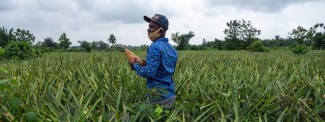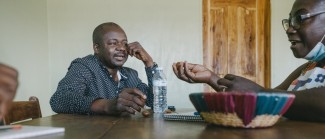The Covid-19 pandemic has exacerbated the challenges Least Developed Countries (LDCs) face in accessing vital trade finance, as many have seen their local dollar liquidity shrink while foreign banks take a dimmer - and not always accurate - view of emerging market risk. Development banks, international organizations and LDCs themselves are however working to bridge the trade finance gap by improving product knowledge, mitigating compliance risk and investing in digitization.
LDCs have long been disproportionately impacted by a global trade finance gap that the Asian Development Bank estimated in 2019 exceeded $1.5 trillion. Many, including the WTO, believe this to have widened since. A recent report by the African Export-Import Bank (Afreximbank) confirmed that in the first four months of 2020 around 38% of local banks in Africa reported rising rejection rates for trade finance instruments like letters of credit while more correspondent banking relationships were cancelled.
LDCs are particularly vulnerable to global shocks, such as financial crises or the current pandemic, which either weaken international banks' risk appetite or trigger a surge in competing financing demand from other countries. This is in part because LDCs must effectively "import" such finance from foreign banks. Low savings rates in LDCs mean local banks usually have only small deposit bases from which to lend.
The pandemic has also hurt many LDCs’ exports and remittances, shrinking their access to US dollars - a currency required in 80% of global trade transactions. A deterioration in many LDCs’ sovereign risk during the pandemic, as lockdowns eroded GDP and increased external debt, also impacted lenders’ perception of their private-sector risk. This has made it harder and more expensive for LDC companies, and especially SMEs, to secure trade-related credit lines.
Funding and guarantees
Multilateral development banks (MDBs), development finance institutions (DFIs) and international organizations have rallied to support trade flows through the crisis with a string of coordinated trade finance facilitation programmes.
For example, the World Bank’s International Finance Corporation (IFC) stepped forward with $2 billion in funding and risk-sharing via its Global Trade Liquidity Program and Critical Commodities Finance Program. Its Global Trade Finance Program tabled an additional $2 billion to cover financial institutions’ payment risks to encourage them to offer trade financing, especially to SMEs.
In March 2021, Afreximbank approved a $3 billion Pandemic Trade Impact Mitigation Facility (PATIMFA). This was on top of the $1.5 billion pandemic response facility (COPREFA), offering direct funding, guarantees, documentary credit confirmation and cross-currency swaps to African firms, commercial banks and central banks.
WTO Director General Ngozi Okonjo-Iweala acknowledged in May however that the estimated $35 billion provided by MDBs over the past year will merely dent the global trade finance gap. She stressed the importance of trade finance for LDCs and urged WTO members to accelerate efforts to develop a dedicated trade finance work programme.
Investing in expertise
Plugging knowledge gaps around trade finance and its various instruments is crucial to helping improve LDCs’ access. Several trade finance facilitation programmes therefore include technical assistance components that extend training to trade finance professionals at banks in low-income countries.
In October 2020, the Enhanced Integrated Framework (EIF) also joined a renewed alliance between the Islamic Trade Finance Corporation (ITFC) and the International Chamber of Commerce (ICC) Academy, which offers training and certification for trade finance professionals. The alliance funds the cost of training for representatives from LDCs, with graduates so far hailing from Rwanda and Bangladesh.
In many developing and developed countries it can be difficult to identify specific impediments to trade finance. LDCs could therefore benefit from trade finance being included in the EIF’s Diagnostic Trade Integration Studies (DTIS) and incorporated into countries’ trade development strategies from the start.
This is currently only done if LDCs request it, and although interest is growing among Asian countries - with trade finance diagnostics successfully completed for Myanmar and Cambodia, for example - African nations have been slower to take advantage of the opportunity.
Strengthening compliance
Bolstering awareness of regulatory requirements around know your customer (KYC), anti-money laundering (AML) and combating the financing of terrorism (CFT) among trade finance providers in LDCs and other low-income countries is also important for reducing the likelihood that international banks will “de-risk” out of emerging market trade finance.
A joint publication by the WTO and IFC showcases the efforts of several agencies in this area. These include the running of workshops aimed at promoting tools to make compliance more effective and less costly for local banks, to disseminate broader good practices in trade finance, and help them attract new correspondent banks. Countries benefiting from such workshops include Djibouti, Ethiopia, Liberia, Rwanda and Zimbabwe.
Compliance is also a key focus for Afghanistan. Following an overhaul of the country’s regulatory frameworks around AML and CFT, partly supported by the World Bank and WTO, Afghanistan graduated in 2017 from the Financial Action Task Force’s “grey list” of jurisdictions with deficiencies in these areas, notes Ajmal Ahmady, Governor of Da Afghanistan Bank, Afghanistan’s central bank, and previously Minister of Commerce and Industry.
It continues to prepare for a follow-up “mutual evaluation” in 2023 that Ahmady hopes will demonstrate to correspondent banks that Afghanistan is a safe place to do business, so help expand the country’s nascent trade finance market.
It is important however to strike a careful balance, ensuring regulatory rigour - for example, around KYC and mobile money transfer limits - does not create administrative hurdles or disincentivize the formalization of trade in LDCs, Ahmady cautions. “If you have to submit your passport for a $1 transaction, I think most people would agree that’s over-zealous.”
Payments Digitization
LDCs also need support from organizations like the WTO to develop trade finance products that incentivize companies to finance trade through formal banking channels, Ahmady adds.
Although Afghanistan’s trade remains mostly cash based, with minimal trade finance support so far, it has invested in a digitization push that Ahmady believes will help change this. Having spent the last year tackling technical hurdles associated with integrating banks and mobile companies into the country’s mobile payments system, he expects electronic transfers to significantly increase over the coming year and beyond - and for this to facilitate the formalization and financing of trade.
While previously a trader at the border would have to take his Customs invoice to a central bank branch to make the payment, “because we have now connected all the banks with the central bank electronically, that person can now go to any bank to make a payment for a Customs invoice,” he notes. “The next step will be then allowing him to make payments via his phone for that invoice or Customs payment directly to the Ministry of Finance. Those are the capabilities we’re working on.”
For Afghanistan to next tap opportunities in domestic and cross-border e-commerce, websites and shops must be able to accept payments online. This will only happen once merchants are able to spend money in the system rather than immediately cashing out. Such payments and digitization reforms will over time significantly improve trade finance opportunities for exporters, Ahmady believes.
If you would like to reuse any material published here, please let us know by sending an email to EIF Communications: eifcommunications@wto.org.



